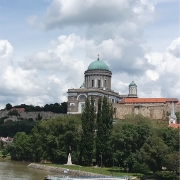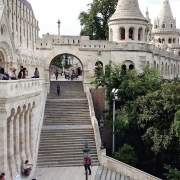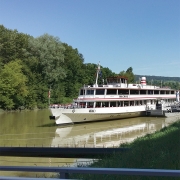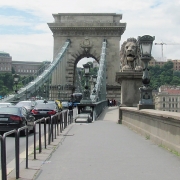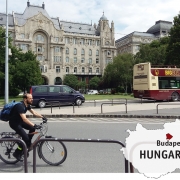
Etcetera
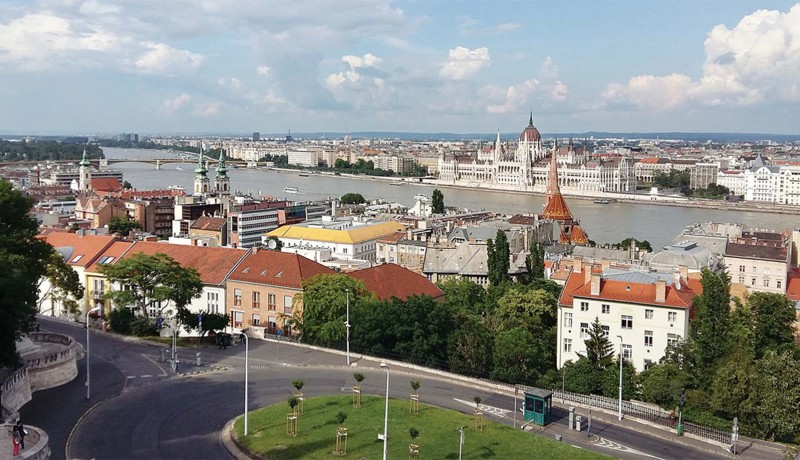
Following the course of Europe’s second longest river through Budapest and Wachau Valley offers a glimpse of history and period architecture
Come summer and the urge to take a respite from blistering subtropical heat is strong. It’s an opportune time to look at Europe, with destinations that bask in benign temperatures with long daylight hours that give way to mildly cool evenings. Reason enough to inspire us to make a tryst with the Danube, following the river along the Hungarian capital, Budapest, and onwards to Wachau Valley in neighbouring Lower Austria.
Our itinerary was consonant with the pages of history as this river—the second longest in Europe—has witnessed a period when the kingdoms of Austria and Hungary were united under the Austro-Hungarian Compromise of 1867. Ruled by the House of Hapsburg, the Austria-Hungarian Empire endured right until World War I, a time when Austrian composer Johann Strauss II wrote the famous An der schönenblauen Donau, The Blue Danube Waltz, the strains of which have continued to haunt music lovers over the ages. The Danube, though, is not exactly blue. More often than not, its waters are in shades of green, at times even muddy—and it creates scenic splendour wherever it flows. In Budapest, the river embraces the city on both sides, the capital being the outcome of two independent cities, Buda and Pest, which united with the Roman settlement of Obuda in 1873. Of all the bridges across the river, the most splendid is the Széchenyi Chain Bridge, designed by English engineer William Tierney Clark in 1849.
Besides the obvious charms of the river, Budapest on its own is a jewel of a city, resplendent with sumptuous period architecture. I find myself looking skywards in several photographs of the trip. I simply could not stop admiring the craftsmanship that expresses itself in myriad forms, whether it is the embellished exteriors of churches, palaces and buildings or the high-vaulted ceilings and domes.
We selected a conveniently located hotel in Deák Ferenc tér on the Pest side, a central square downtown, and a great transport hub for the metro, trams and buses. It is best to buy a carnet of tickets from the station office, and use them at will on any of these modes of transport. Walking, however, is the best means to absorb the atmosphere. We headed for Chain Bridge, on the way sauntering into the lobby of the heritage Gresham Palace Hotel by the Four Seasons for our ‘Elevenses’ cup of tea and delicious cake—the patisserie tradition of this region is famed—under the Art Nouveau glass dome of the tea lounge. Outside, after another pause to admire the Hungarian Academy of Sciences, we crossed the bridge to take the Castle Hill funicular up to Buda Castle, where the statue of the mythological Turul bird gazes down at the Danube below.
The district is a mind-boggling treasure of historic sights and museums, laced with cobbled streets and medieval houses, as its first inhabitants moved up here in the 13th century. Two centuries later, it became the seat of the Royal Court, when under the rule of King Matthais, Buda became one of Europe’s most influential cities. Then came the Turks from 1541 until 1686, followed by the Austrian Hapsburgs, who introduced the elegance of Baroque architecture. Many sights were ravaged under the Occupation after World War II, but have since been restored.
Exploring the Royal Palace with its several courtyards, gardens, art gallery, National Library and History Museum took up the better part of the morning, whetting our appetite. It called for a break in one of the many restaurants and cafes that dot the district. We decided to combat the summer sun with a glass of chilled Hungarian beer. For lunch, we had a serving of Hungarian goulash, a meaty soup with a strong accent of the famed regional paprika, accompanied by potato dumplings.
Next, we were on to Szentháromságtér or Holy Trinity Square in the heart of the district with its landmark Matthais Church. Behind it, at the edge of the hill, we joined the tourist crowd at the Fisherman’s Bastion, a lookout terrace with intriguing neo-Gothic arches and neo-Romanesque turrets—the seven towers representing the seven Hungarian chieftains of ethnic Magyar tribes who first settled down here.
The adjacent Hilton Hotel with its modern glass façade seemed a contrast, but a closer look revealed some remains of the castle wall. In the depths of a tunnel below the hotel is the Faust Wine Cellar where one can enjoy tastings of Hungary’s famed wines, especially ‘Bull’s Blood’, red wine from Eger. Moving on to the gothic Mary Magdelene Tower, we skirted the National Archives and Museum of Warfare to take a walk on Tóth Árpád promenade. Bordered by trees, houses and hills, it is charmingly romantic, with sweeping views that include the handsome Hungarian Post Office Headquarters heritage building.
Close to 6 pm, with tired feet and exhilarated hearts, we exited the district from the medieval Vienna Gate. We could have started our tour from this end or taken a Castle bus, but the walk served to remain etched in memory. We stepped into one of Budapest’s famous yellow trams from Széllkálmántér, located at the lower end. We made a stop at Margaret Island, located in the middle of the river, to enjoy the musical fountain and the laughter of children as the sun came down.
At dinnertime, Budapest swings, especially the Pest side. Take your pick from bars, international cuisine restaurants, and the unique ‘ruin pubs’—ruined buildings transformed into lively bars, like the popular Szimpla Kurt, where youngsters pack verve to musical beats and food. We preferred Gozsdu Courtyard in Király Utca street near our hotel. Here, seven old buildings and their courtyards are knitted together to provide a host of eateries. Our next few days were a swirl of sightseeing, browsing and relishing Hungarian culture and summer bonhomie.
The Parliament Building with its grandiose Renaissance-style dome and intricate workmanship around its Gothic windows and turrets with spires is a sight not to be missed. We took the highly recommended guided tour to see its rich interiors, especially the legislative chamber.
A walk down Andrassy Avenue, a beautiful tree-lined boulevard with fashionable branded shops and the Opera House; Heroes Square, a complex of iconic statues in a semi-circular colonnade on either side of the Millennium Monument, erected to commemorate the 1,000-year history of the Magyars; a day excursion to Gellert Hill, trekking up to the citadel or fortress and Liberty Statue, the highest point in western Budapest; Dohany Street Synagogue—the largest in Europe—with its gold embellished minarets and circular windows; the Danube Bank memorial, where sculptor Gyula Pauer has created 60 pairs of realistic shoes out of iron, a remembrance to the 3,500-odd victims who were ordered to take off their shoes and shot at the edge of the water by fascist militia during World War II, are some of the highlights of the town.
Keep aside a day for thermal baths as well. Pamper yourself in these spas with dreamlike settings of arched walls, Roman columns and domes. The largest, Széchenyi Baths, boasts 18 pools, 15 of which are spring-fed thermal pools. We chose the elegant Gellért Baths, built in Art Nouveau style in 1918. One can also enjoy the bustle of shopping streets, the most famous being Váciutca or Fashion Street that runs from Vörösmarty Square to the picturesque 19th-century Central Market Hall, the oldest indoor market in Budapest. Its neo-Gothic entrance gate and quaint roof with colourful tiles prompted us to whisk out our cameras. Inside, we found restaurants and stalls selling fruits, vegetables, pickles, meats, pastries and paprika.
For anyone craving cultural extravaganza, an operetta performance in one of Budapest’s atmospheric theatres is a must. Though we had no such luck, we enjoyed an enchanting classical music performance under the exquisite high dome of St Stephen’s Basilica, the largest church in Budapest. We emerged, to rejoin summer tourists listening to a foot-tapping performance by a pop group in the park.
One of the highlights of our trip was a day excursion to the Danube Bend. Some 50 km north of Budapest lies the most idyllic stretch of the Danube. Here, sloping hills on both sides of its banks cajole the river to bend sharply and flow southwards. Along its banks lie the charming towns of Esztergom, Visegrad and Szentendre. An hour-and-a-half by train from Budapest, Esztergom impressed us with its columned frontage and the neo-classic dome of its Basilica. More thrills followed as we traversed Mária Valéria Bridge, crossing borders over the river onto Sturovo, in Slovakia.
Besides taking in some marvellous perspectives of the river bend, there was that childlike kick of having visited yet another country! The next town, Visegrád, had to be tackled in fast mode, time ticking uncomfortably quickly. We stopped at the Nagymaros ferry, crossing for tea at a riverside restaurant, content with the charming view of the Royal Palace and Citadel complex nestling high amid the hills across the waters, the town spreading out below in obeisance. We made it to Szentendre just in time to walk through its cobbled Old Town and taste its crystal waters from an ancient well with a charming hand-pump in the town square, a living declaration of its past. After a stroll by the Danube Promenade in the setting sun, it was time for us to take the train back to Budapest.
It was nightfall on our return; the city dazzled and the waterside took on the surreal dimensions of a movie set. Chain Bridge with its illuminations glittered against the canvas of the floodlit Royal Palace and Buda Castle in the backdrop. On the Pest side, the floodlit magnificence of the Parliament Building by the river claimed our attention. Though a dinner cruise on the Danube is touted by tourist brochures, we were content to dine in an outdoor riverside café, marvelling at the shimmering night lights weaving a golden tapestry on the inky waters.
Our next rendezvous with the Danube was reserved for the second part of our itinerary: a visit to the neighbouring Lower Austria and a whole day cruise through the famed wine regions of the Wachau Valley.
A three-hour train ride from Budapest took us to Melk, the starting point of the cruise. Although it lies just 45 km west of Vienna, this charming little town lives in a cocoon, away from urban noise. Over the next two nights of our stay, the only sounds were the soul-touching chimes of the bells of the Benedictine Melk Stift (abbey) striking the hour. This 11th century monastery flourished under the Hapsburgs and remains beautifully preserved. Its baroque architecture with a stunning domed cathedral spreads out in quiet glory on a rocky outcrop above the town.
In the evening, while sitting outdoors under an indigo sky in the cobbled street of Old Town square, where we had booked ourselves in a small family-run pension (lodging) to enjoy local ambience, the floodlit abbey created an ethereal mood as we dined on wiener schnitzel, a typical Austrian breaded pork dish, and local wine from the region.
Next morning, after a chat with the pension owner while downing cups of coffee over a selection of home-baked breakfast rolls, we took the local minivan to the cruise point. We were happy to join the crowd of fellow holidaymakers, most of them silvers, eager to tune into the rhythm of nature. As our cruise ship glided over emerald waters, we whisked out our hats, perching on the terrace deck. Our hop-on, hop-off cruise ship made its first stop at Spitz, a small town that sits amid vineyards that clamber all over the hills. We followed steep curving pathways, lined with neat cottages, vines growing even in small backyards. After a quick look at the gothic-style St Maurice Church in the town square, and a quick sandwich picnic on the park bench—with a bottle of flavourful light wine, of course—we were back to the wharf to take the next scheduled liner.
Our next halt, Durnstein, enchanted us with its medieval character. We made a challenging climb to its castle ruin, keen to see where King Richard, the Lion Heart of England, was kept captive during the Third Crusade. All fatigue evaporated at the bird’s-eye view of Lilliputian houses punctuated by neat rows of vineyards and the landmark blue Augustine abbey by the glistening river. Back to the stone archway leading to the Old Town, we barely had our fill of its cobbled alleys, making a short cut through a fairytale narrow passage to take a boat to our final destination, Krems an der Donau, or Krems-on-the-Danube, a city 40 km upstream from Spitz, which marks the end of the UNESCO-protected Wachau Valley.
At Krems, we could see layers of the past in Old Stadt or Old Town, the 15th-century Steiner Tor (gate) and the baroque Rathaus, the town hall that reminds one of Melk Abbey, as it was built by the same architect. Before leaving, we took a very special photograph. It wasn’t of any monument or building; of those we had plenty. It was a beautifully rendered tourist map outside the Old Stadt, showing the course of the Danube winding its way through Wachau Valley. We simply had to take that shot. The river flows on, but it creates memories that stay.
FACTFILE
WHEN TO GO
Budapest is best visited April onwards until October; for those who like the cold, till November. It is springtime from mid-April, although temperatures are still cool, ranging from a maximum of 16.4oC to a minimum of 7.6oC. By June, the weather gets warmer, with long sunny days and cool evenings. July to August is likened to Indian summer, which means it can be fairly hot. By September it tapers off, and October ushers in temperatures as low as 7oC. By November, the days are short, with sunset by 5 pm, but for the enthusiast, this is the theatre and opera season, and the beginning of Christmas markets. Always carry your brollies, as fanciful clouds can give way any time. May to September would be the best time for the Danube cruise.
VISA & CURRENCY REQUIREMENT
Like anywhere in the European Union, a Schengen tourist visa is required. There are no direct flights to Budapest from India, though there are several airline carriers with connections. We flew into Budapest and took a return from Vienna, which is just 85 km from Melk, with a very reasonable fare. While Austria uses the Euro (about ₹ 73-74 for one Euro), Hungary uses its local currency, the Hungarian Forint (4.24 HUF for one rupee).
TIPS
- For a good currency rate, it is recommended that you change your currency at a bank in Budapest, rather than at one of the several money changers you may find in the touristy areas. Airport exchange rates are also high.
- It is best to book your hotel on the Pest side, as it is lively at night. The Buda side and Castle District also have some good hotels and restaurants, though it tends to get rather quiet during the evenings.
- Book your Parliament tour online beforehand. The tour is much in demand as entry into this splendid building, which also houses the Hungarian crown jewels, is not allowed without a guide. On any given day, there are guided tours in many languages, including English. Each tour has limited places and on-the-spot tickets may be hard to find. The website for bookings is: Jegymester.hu. Opera and theatre tickets can be booked on the same website.
- For the Danube cruise in the Wachau Valley, tickets can be purchased on the spot at the jetty as there is a relay of ships that go down the 24-km valley upstream from Krems or downstream from Melk. Brandner Cruise Line and DDSG Cruise Line both offer day cruises, in addition to a host of other cruise lines that offer cruises along the Danube, including a river cruise from Budapest to Wachau Valley.
Text & Photos: Rekha Sarin Featured in Harmony — Celebrate Age Magazine April 2017
you may also like to read
-
Cracking the longevity code
Small yet impactful choices can be game-changers, writes Srirekha Pillai At 102, there’s no stopping Chandigarh-based Man Kaur, the world’s….
-
Home, not alone
While a regulatory framework is vital for senior-care facilities, the need of the hour is to develop an ecosystem to….
-
Birthday Girl
Published in a special edition to honour Japanese master storyteller Haruki Murakami’s 70th birthday, Birthday Girl (Penguin; Rs 100; 42….
-
A huge treat for music lovers
Published as the revised and updated second edition, Incomparable Sachin Dev Burman (Blue Pencil; Rs. 599; 470 pages) the authoritative….



